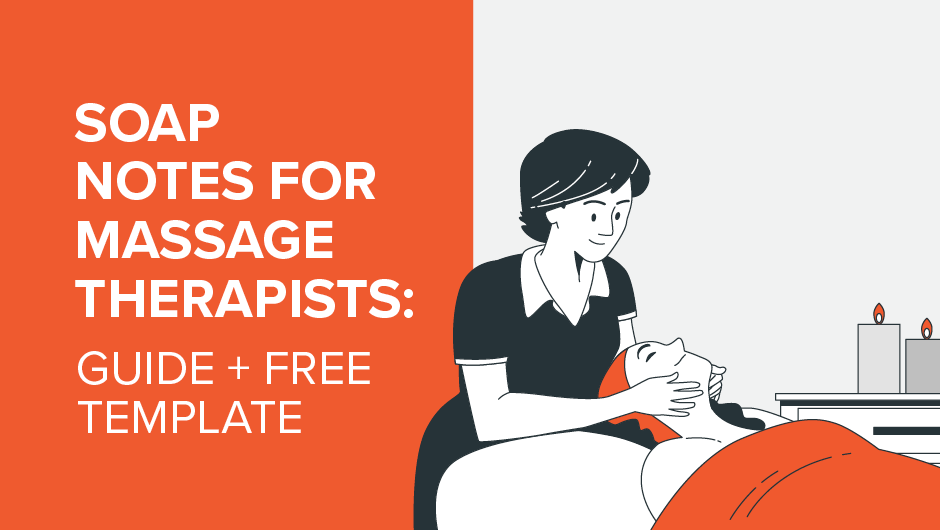Contents
Thorough client records are essential for remembering these crucial details and providing a stellar massage experience. A central part of these records should be the SOAP notes you take before and after your clients’ sessions.
In this guide, we’ll help you implement massage SOAP notes for your practice by covering the following topics:
- What are SOAP notes?
- Common SOAP notes abbreviations for massage therapists
- Example SOAP notes for massage therapists
- SOAP notes for massage therapists FAQs
- Why SOAP notes are important for massage therapists
- 3 tips for writing more effective massage SOAP notes
- SOAP notes for massage with MassageBook
SOAP notes help massage therapists create treatment plans and track their clients' progress, ensuring they provide the best service possible. They’re also extremely beneficial if your practice accepts insurance as a billing option or collaborates with other healthcare providers. Let’s get started!
SOAP notes are a note-taking format that massage therapists and other healthcare workers use to document their client sessions. Having a standardized format helps you to stay consistent and organized and allows you to focus on the most important parts of your massage session.
SOAP is an acronym:
- S = Subjective
- O = Objective
- A = Assessment
- P = Plan

Let’s take a deeper look at each part of this acronym.
S = Subjective
The subjective portion of SOAP notes includes information that the client tells you in their own words. It also contains your impression of the client’s condition. This information is usually gathered in your initial intake interview and may be supplemented by feedback from the client as your treatment progresses.
Common information noted in the subjective section includes:
- Client’s description of the chief complaint (CC)
- Client’s goals regarding their CC
- Relevant medical history, injuries, or other information
- Client’s perception of their progress
If you have repeat clients, update the subjective section of their notes on how they’re feeling and how it’s changed from their initial status. This will ensure that you’re delivering effective massage treatments.
Subjective example: Client indicates pain in right shoulder that persists when standing and sitting. At-home ice therapy has had no effect. Client rates pain level as 4/10. Client has had a previous shoulder injury from playing basketball.
O = Objective
The objective section of your massage SOAP notes covers your clinical findings and data from observation, palpation, or reassessment tests. Usually, this section includes:
- Observations from assessment or reassessment
- Progress toward goals based on objective findings
- Details of specific treatments and modalities provided that day
- Observable or palpable response to that day’s massage treatment
Massage therapists commonly add information about:
- Limps
- Muscle guarding
- Holding patterns
- Movement inconsistency
- Atrophy
- Hypertrophy
- Bruises
- Abrasions
- Scars
- Swelling
- Redness
- Skin irregularities
- Varicose veins
- Breathing patterns
- Prosthetics
Although it may be tempting to diagnose your client based on the information in this section, keep in mind that the information here should be objective. Be specific with your details and avoid making value judgments or letting bias or personal opinions influence your notes.
Objective example: Client has tightness in the muscles of the neck and shoulders and hunches over when seated. There is also redness on the right shoulder.
A = Assessment
The assessment portion of SOAP notes for massage details how the client is progressing through your massage therapy plan. Usually, it covers the following information:
- Your clinical opinion about your client’s progress toward treatment goals
- Client’s overall response to the day’s massage treatment
- Any negative reactions to the day’s treatment
- Precautions or pre-existing conditions that may respond negatively to massage therapy
If you accept insurance billing at your massage practice, this section of your SOAP notes will be closely scrutinized. Insurance providers want to know if the client is progressing toward their goals and if they should be reimbursed for the treatment. Ensure that your notes are thorough and include the details that the insurance provider is looking for.
Assessment example: Conducted range of motion tests, significantly improved after treatment. Client reported 0/10 pain after treatment.
P = Plan
The last section for SOAP notes is the plan section, where you describe the massage treatment you intend to implement. This includes long-term treatment plans and lifestyle recommendations. Your notes should cover:
- Plan for future visits
- Updated goals
- Recommendations for frequency and duration of massage treatments
- Reassessment reminders
- Client’s self-care plan
- Referrals
- Notes on medication
For the most recent visit, you should note what worked and didn’t work this time, what to focus on next time, and anything missed. You can also add educational recommendations for the client so that they can learn more about relieving their pain.
Plan example: Next week, focus on neck and shoulders and review stretches and self-massage techniques after a long day of standing.
Common SOAP notes abbreviations for massage therapists
Most massage therapists and medical providers use certain abbreviations when taking SOAP notes to speed up the process. Here are a few common SOAP note abbreviations:
| Abbreviation | Meaning |
| + | Positive |
| - | Negative |
| C/O | Complains of |
| P | Pain |
| (L) | Left |
| (R) | Right |
| /7 | Days, e.g. 2/7 = 2 days |
| /24 | Hours, e.g. 2/24 = 2 hours |
| /60 | Minutes, e.g. 20/60 = 20 minutes |
| /12 | Months, e.g. 2/12 = 2 months |
| Abd | Abduction |
| Add | Adduction |
| Fx | Friction |
| Dx | Diagnosis |
| GRM | General relaxation massage |
| FBM | Full body massage |
| DTM | Deep tissue massage |
| MFR | Myofascial release |
| STM | Soft tissue massage |
| TP | Trigger point |
| EFF | Effleurage |
| ele | Elevation |
| Pet | Petrissage |
| Palp | Palpitation |
| MET | Muscle energy technique |
| MLD | Manual lymphatic drainage |
| P/R | Press and release |
| ROM | Range of motion |
| abs | Abdomen |
| gluts | Gluteus muscles |
| H&N | Head and neck |
| delt | Deltoids |
| LB | Low back |
| BA | Back ache |
| HA | Headache |
Remember: prioritize clarity above all else. The time you save from speeding up your note-taking process won’t be worth the time spent going back and forth with an insurance biller or other providers to clarify your notes.
It’s crucial to standardize your abbreviations to avoid confusion, especially if multiple providers are treating the same client or if you bill your services through insurance. Keep in mind that not all SOAP note abbreviations are standardized across different medical fields. For example, the abbreviation “Fx” stands for friction for massage therapists, but stands for fracture in other medical fields. If you have clients who see multiple medical providers, clarify your notes to ensure no misunderstandings.
Example SOAP notes for massage therapists
Let’s review a quick example of SOAP notes a massage therapist might take during an intake appointment:
Client name: John Doe
Date/time: 01/27/25
Session duration: 1 hour 30 minutes
Subjective: Client’s primary complaint is tightness and soreness in the neck and shoulders, “I just want to feel less tense in my neck and shoulders.” No pre-existing injuries or conditions, but he believes that discomfort is caused by full-time job, which requires him to sit at a computer 8/24. He notes that his sitting posture is not the best, “I’m always hunched over like a shrimp.” He rates his pain at about 3/10.
Objective: Client is male and 32 years old, standing at 5’10 and weighing about 150 pounds. Asked to sit down and pretend to work at computer - posture is unideal, head juts forward and shoulders are hunched forward. Tested range of motion for neck; client experiences discomfort when rotating head from side to side. Performed Swedish massage on client, focusing on neck and shoulders.
Assessment: Client says shoulders and neck feel much less tense and that discomfort when rotating head from side to side has vanished. Rates pain as a 0/10. During the massage, the client said some areas of his neck felt sensitive or tender to the touch and requested less pressure.
Plan: Recommended client return for treatment monthly or on an as-needed basis, whenever he feels his neck and shoulders are too tense. Also referred client to online resources on proper sitting posture. Reassess posture on next visit and discuss ergonomics—client says he’ll bring photos of his workspace to next appointment.
To help you start taking SOAP notes at your massage practice, we’ve created a template you can download for free. Simply enter your email into the form below, and you’ll get access to an interactive digital template and a printer-friendly version!
SOAP notes for massage therapists FAQs
Do massage therapists have to keep SOAP notes?
It’s not mandatory for massage therapists to keep SOAP notes. However, it is a best practice that plenty of therapists follow, as it can protect you from legal liabilities and facilitate better care of your patients. In fact, 40% of all massage practices use SOAP note software for charting.
If you are planning to bill massage treatments to insurance providers, then you will need to take SOAP notes. These records will be viewed by the insurance provider to ensure that you are providing the services you’re billing for and to evaluate whether the patient has improved.
Should I take SOAP notes every massage session?
Your SOAP notes will likely be the most thorough and lengthy during your intake session. During future massage sessions, you will probably have much less to write down, as the information may become repetitive. Therefore, it’s good to review your SOAP notes before and after every session to make updates as necessary.
What do I do if I make a mistake on a SOAP note?
If you make a mistake on a SOAP note, cross it out and write the date and your initials. This way, any third parties who view the note will be able to understand that you made an error and when you corrected it.
How do I keep my SOAP notes organized?
To keep your SOAP notes organized, maintain a consistent format and structure. Then, establish a system for organizing and storing notes. A digital SOAP notes solution can greatly help with this, as you won’t need to worry about loose papers or physical filing systems. Instead, you can pull up a customer’s notes straight from your database.
Does HIPAA apply to SOAP notes?
There are HIPAA regulations that apply to SOAP notes. Since SOAP notes contain confidential data, you must store them safely and securely. Whether you choose to store your SOAP notes physically or digitally, you should have safeguards to ensure the protection of your clients’ information. Stay apprised of HIPAA regulations to keep your notes in compliance.
Can clients view their SOAP notes?
You are legally required to provide clients with their SOAP notes should they request to view them. Therefore, your documentation must remain professional and easily understandable. Your SOAP notes are a reflection of the quality of care at your massage practice and should leave your clients with a positive impression of your business after reading them.
Why SOAP notes are important for massage therapists
Here are a few reasons why it’s important for massage therapists to take SOAP notes:

- Professionalism: Taking thorough notes demonstrates to clients that you take their health and satisfaction seriously. This builds trust and fosters stronger relationships with clients, improving your practice’s reputation.
- Client safety: Some of your clients may have preexisting conditions or injuries that make massage therapy painful. Noting these conditions will help you give clients the care they need, from the moment they step into your massage room to the moment they leave.
- Treatment planning: In your SOAP notes, you’ll document your client’s specific needs and goals for their massage therapy. Review these notes prior to your client’s next session to refresh your memory and plan what that session will look like.
- Progress tracking: SOAP notes provide benchmarks for tracking progress and building a historical overview of your client’s treatment. Update your SOAP notes to ensure they stay up to date so you can make informed decisions about any adjustments to your treatment strategy.
- Communicate with other providers: If your client is seeing you for pain or other medical reasons, they may also be seeing other medical providers. SOAP notes allow you to communicate and coordinate with other healthcare professionals about your clients’ care.
- Liability and legal protection: In cases of legal disputes, SOAP notes serve as a record of your client’s sessions. They can be used to demonstrate that you followed proper protocols and standards of care, protecting you from liability issues.
Massage SOAP notes empower you to maintain a consistent record-keeping process. Plus, because of its consistency, you’ll always know what to write and how to write it, saving you time and brainpower. Having such a notetaking system in place now will also help you as your practice grows and hires new therapists, as you’ll be able to communicate consistently with each other through your notes.
3 tips for writing more effective massage SOAP notes
To help you write more effective massage SOAP notes that enable you to give your clients the care they need, let’s dive into a few tips!

1. Write timely notes
Take notes in a timely manner to capture all the important details. This means that you should take notes during your intake appointment and immediately after massage therapy sessions, when the information is still fresh in your mind. If you wait a few hours or even days, then you may forget relevant details.
After you’re done with your notes, review them carefully. Make corrections or additions if you find any errors or if any key information is missing. For example, if you filled out the subjective and objective sections during your intake appointment, but a few appointments later, the client brings up that they recently hurt their knee, then update your notes to include that.
2. Keep your notes brief but comprehensive
SOAP notes are, at the end of the day, notes. That means that they should contain key information, but not necessarily be a record of everything that happened during your massage session. Although it may seem contradictory, you want your notes to be brief yet comprehensive.
For example, if you and your client discuss the latest football game during the massage, you should not include this information in your notes, as it does not pertain to their care or treatment. On the other hand, if your client has many health issues they’d like you to be mindful of, you should thoroughly document these concerns instead of prioritizing brevity.
Another way you can keep your notes brief is by incorporating abbreviations, which we discussed earlier in this guide. This practice reduces the time spent on note-taking and makes your notes shorter.
3. Create a thorough note-taking process
Create a note-taking system to standardize your process and ensure nothing falls through the cracks. For example, if you prefer to take notes by hand, print out diagrams of the human body and annotate them to indicate exactly where the client is feeling pain or discomfort. Designate a filing system for your notes as well, such as by using individual folders for each client’s notes.
Or, if you wish to write notes digitally, search for a solution that allows you to add your SOAP notes to your client’s digital records. That way, you can easily access your notes before and after each session to reference them, make updates, and provide the best possible client care.
SOAP notes for massage therapists with MassageBook
MassageBook’s massage therapy solution gives you access to faster, more detailed, and more useful SOAP notes for massages. Our solution provides the following features:

- Customizable intake forms: Send secure, customizable intake forms to clients after they make an appointment so they don’t have to fill out paperwork on the day of. Plus, you can review these forms before your clients arrive, ensuring you can prepare for their appointment.
- Drawing tools: Annotate your findings directly on an anatomy chart to keep your notes organized and accurate. You’ll have access to various tools and colors to create the perfect visuals.
- SOAP note reminders: Our solution will remind you if you’ve missed writing SOAP notes for any of your clients. That way, you will remember to take notes that make your client’s next session more productive.
- Organized database: Our client database lets you track client activity and client-specific information, including your SOAP notes. You’ll be able to easily pull up any SOAP notes you need to reference or update before and after your appointments.
For a deeper dive into our SOAP notes features, check out this video:
If you’d like to save more time, record professional-quality SOAP notes, and get rid of your paper filing cabinet, now’s a perfect time to discover how MassageBook’s SOAP notes feature can help you reach new levels of productivity. We offer a 30-day free trial so you can truly explore how our SOAP notes help you boost client care.
Additional resources
SOAP notes are an extremely useful tool for massage therapists, whether you’re a single practitioner or you run a larger practice. Hopefully, you now understand why it’s important for you to use SOAP notes in your practice and how they can help you provide a higher level of care to your clients.
If you’re interested in learning more tips for improving your massage practice, check out the following resources:
- 13 Best Massage Therapy Software Solutions — If you’re looking for another way to upgrade your massage practice’s operations, consider investing in massage therapy software. This guide explores the top solutions to consider.
- A Guide to Massage Billing: Insurance Codes for Therapists — Accepting insurance payments for massage therapy has various benefits and drawbacks. Read this article to learn more about whether it’s the right choice for your practice.
- Massage Therapy Marketing: 15 Effective Ideas to Explore — A profitable massage business needs more than great service; it also needs a thorough marketing strategy. Discover the most effective massage therapy marketing strategies here.







